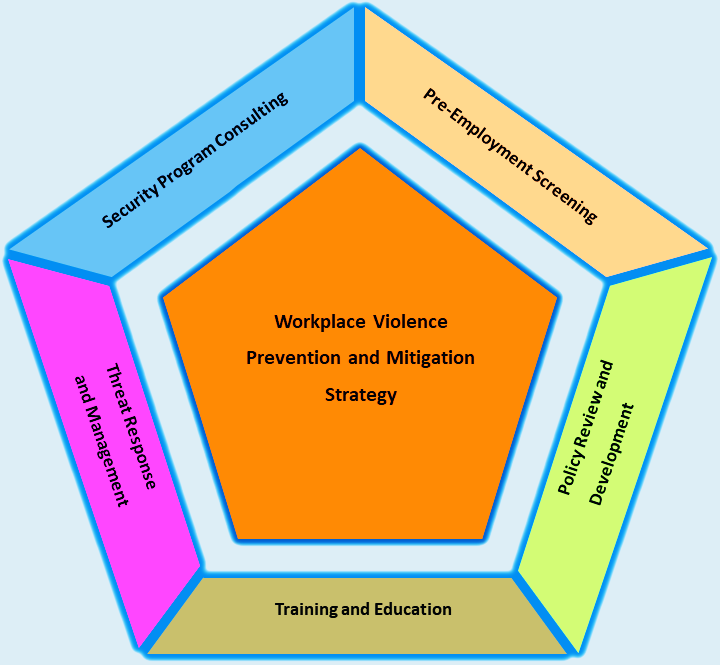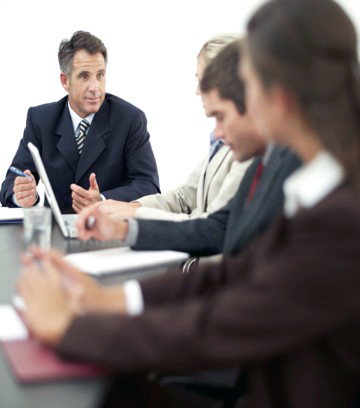|
||
|
Risk is an unavoidable part of any operation or organization. The risks workplace violence threats and acts of violence pose are no exception. Properly managing risks are always the best business decision. Workplace violence throughout the United States has sadly become part of our everyday lives. From workplace murders to school shootings to acts of domestic violence, our society is more violent than it has been at any time in the past. Worse yet, it is not getting any better. While there are many theories about why there is an increase in the incidences of workplace violence, there is widespread consensus that it is a significant problem for society and especially for the innocent victims in the places where we work, learn, and live. The Conley Group is the only company in the Midwest, and perhaps beyond, that can provide organizations with a well-developed and comprehensive Workplace Violence Prevention and Mitigation Strategy. With nearly 50 years of direct experience, and managing more than 1,000 workplace violence threat incidents, we are trusted as the single-source group that can provide real solutions to significant threats that employers seemingly face every day. The Conley Group has had the honor of being recognized globally, as well as nationally, as the best-in-class security organization. Our company is comprised of well-educated, highly experienced, and professionally certified security experts who can work with you and your staff to give you the best chance of achieving a successful outcome with difficult security and personal safety challenges. Employers in the private sector, not-for-profit organizations, and government agencies are all under the threat of an act of violence occurring. Perhaps the most important question is, can workplace violence be prevented? The good news is much of it can be prevented and we know how to do it.
Unfortunately, there have been a very high number of workplace violence incidents that
have occurred over the past 40 years in particular. Fortunately, we have learned a lot
about why workplace violence events occur and the motives of active killers because of
the data we have acquired and analyzed from the number of incidents that have occurred.
It is no surprise that individuals who have a history of violent behavior are more prone to
violent acts. "Perpetrator profiles include mentally ill persons who are not properly
supervised or treated, gang members, relatives of injured persons, and drug users." 2
The most common workplace violence incidents occur by an employee of the organization against one or more other employees. While executives, managers, and supervisors are frequently targeted, co-workers are also often targeted. However, it is not just employee-to-employee violence that is a concern. Workplace violence can also be perpetrated by employees of company suppliers, customers, and members of the public. Workplace violence often makes its way to an organization as a result of domestic situations where the current or former significant other of an employee commits an act of violence against the employee at the workplace. This type of attack is far more likely to occur during a time when an employee leaves their spouse due to domestic violence. The non-employee spouse does not know where the employee spouse is living, but he or she knows where the employee spouse works. Workplace violence can and does also occur as a result of traditional criminal activity such as armed robberies. The reasons why individuals typically perpetrate a workplace violence event usually boils down to what perpetrators view as retaliation, revenge, or, in some instances, financial gain. Anyone in any organization who has ever been involved in a workplace violence event will tell you their job and their personal lives are never the same afterward. So, the short answer is the consequences are horrible and terrifying. This is true even for employees and their family members who were not directly involved in, or who were not physical victims of, an actual workplace violence attack.
After a workplace violence incident occurs, there are multiple
Direct Human Costs
Direct Business Costs
We are blessed with having great men and women who comprise the law enforcement
profession. As officers of the Court, the core responsibility of law enforcement officers is
to prevent crime and respond to incidents involving criminal acts. When anyone makes
what is called a "criminally actionable" threat or action, law enforcement should be called
immediately because a criminal act either has been committed or is likely to be committed.
Everyone has Constitutional rights and law enforcement officers are strictly prohibited from taking any action that violates anyone's Constitutional rights. These necessary Constitutional constraints can present a significant challenge involving most workplace violence threat situations. This is because most threats are not "direct" threats such as one person threatening to kill another person outright. By contrast, individuals who are intent on committing an act of workplace violence will very seldom make a direct threat because they know doing so is a crime that can get them arrested. Rather, a potential perpetrator will instead look at a person who is their intended target and aggressively tell them something like, "I'll be seeing you later" or, "You will never see it coming." The person threatened will then usually call the police and report that threat because the person threatened clearly understands that is a threat by how it was said. However, what the police will likely tell the reporting party is what the potential perpetrator said was innuendo and not a direct threat, so there is nothing they can do because no crime was committed. By the time a potential perpetrator shows up with a gun and starts killing people, it is then too late to prevent the shooting. When the shooting starts, and by the time 9-1-1 is called and the police arrive, it is too late to prevent the shooting. That is the exact type of situation where we most commonly become involved. Our objective is to prevent the active killer from being successful in carrying out an act of violence either by prevention or by having adequate armed protective assets on-site to prevent a committed active killer from being successful.
The great news is that most potential workplace violence incidents can be prevented with
the correct advanced intervention. Even within the U.S. Department of Labor's Workplace
The Exclusive Services The Conley Group ProvidesRisk is a core part of any operation. As such, effectively managing the array of risks is essential to an organization's profitability and survivability. Our experience is that most organizations have been unsuccessful in sufficiently mitigating their safety and security risks. This results in those organizations having an inadequate security program. Simply put, an inadequate security program is one that has failed to meet the minimum requirements according to the laws, professional standards, professional guidelines, and best practices. This is important because having an adequate security program can, in and of itself, help prevent a workplace violence attack from occurring. One of the significant pertinent regulations organization leaders should be well aware of is the General Duty Clause in Section 5(a)(1) of the Occupational Safety and Health (OSH) Act of 1970. Although OSHA has no other specific standard on workplace violence, as of 2011, OSHA has held organizations that suffer a workplace violence incident financially accountable under the General Duty Clause. Section 5(a)(1) states:
"(a) Each employer -
While an OHSA fine as the result of a workplace violence incident may not cost the
organization a lot of money relatively, that fine can set up a case for gross negligence and
a punitive damages judgment in a civil court action. As of November 2019, the average
punitive damages judgment for a person killed as a result of a workplace violence incident
was between $40,000.000.00 and $60,000.000.00. Suffice it to say that prevention is a
whole lot less expensive than gambling nothing adverse will occur. Another regulatory and
The simple truth is employers who take a proactive approach to the safety and security of their enterprise are always far better prepared to survive an adverse event than those who are unprepared and reactive. When an adverse event occurs at organizations that have not prepared, it is often too late for anyone to help them. And, the consequences can be devastating. The sad part is, had those organization leaders properly prepared by investing in an adequate security program, the outcome could have been minor or may have never occurred at all. Once an adverse event occurs, it is too late.
There are only two places to solve employee problems. One is at the front door and the
other at the back door. The front door method refers to screening out troubled or
potentially violent applicants, so they are never hired. The back door method refers to an
organization that hires a troubled or potentially violent individual and then has to deal
with terminating the individual after they have been hired and caused problems in the
organization. The front door method is obviously far less costly and risky than is the back
When we are called in to assist an organization with a workplace violence threat, one of the first steps we take is to conduct a deep-dive background investigation into any individual who has made threats or who is otherwise suspected of becoming a possible workplace violence risk. The results of all background investigations we conduct nearly always reveal one or more signs that should have prevented the employee from being hired by the organization had pre-employment due diligence been conducted. Likewise, the result of a background investigation can also help determine when an employee is simply disruptive and not likely to be violent. We can help those who do the hiring identify signs that can and should prevent a potentially violent individual from being considered for employment.
Organizations, irrespective of their size or industry, need comprehensive policies to
establish a clear set of guidelines and information that help direct the effectiveness and
efficiency of the organization's operations. Policies should be a core part of any operation
to communicate an organization's culture, values, and philosophy to all employees. All
policies should cover what employees can expect from the organization as well as what
Policies absolutely have an important role in the prevention of workplace violence because policies should include the expected behavior of all employees. This is often referred to as a code of conduct. Since most workplace violence incidents can be prevented through early detection and appropriate intervention, all employees need to know and report any time a fellow employee does anything violent or says anything that could reasonably lead to an employee committing an act of violence. A part of the policy should be that all employees have a non-optional duty and firm obligation to immediately report any act of violence or any action such as a threat that would give anyone the impression that a person may commit an act of violence.
Counter to the common belief, most workplace violence events do not just "happen" out
of the blue. Rather, there are common factors that can lead up to an individual committing
an act of workplace violence. By organizational leaders providing their managers,
supervisors, human resources staff, and others with the proper training and education,
Part and parcel to having appropriate policies that address workplace behavior, it is essential to provide employees with initial and ongoing education in workplace violence prevention. Our experts with real-world experience can provide classroom-type training to people in organizations so they can become knowledgeable about the elements of workplace violence. This education is an essential factor in fostering a safer, more respectful, and more productive workplace environment by instilling knowledge, reshaping attitudes, and building interpersonal skills. Employee education also promotes awareness for many employees who may not fully recognize subtle forms of harassment and workplace violence. According to one source, "It is widely known that by providing employees with proper anti-harassment and workplace violence training, organizations can create a safer and more positive work environment. Effective training programs should address the different types of workplace violence and equip employees with the skills they need to stay safe." 6 Helping employees build better interpersonal skills that range from conflict resolution and negotiation to de-escalation techniques, provides employees with the tools they need to be able to respond effectively and safely when faced with a potentially violent incident or an actual act of violence. The core objective is to help foster an environment of respect and safety. The Conley Group is the only company in the Midwest that provides a proven and wellestablished threat management and response service. By far, our threat management and response service is the service most in demand of all the solutions we provide. This service is generally initiated by a triggering event within an organization that has received some type of threat or is dealing with a situation involving one or more high-risk people. We have received calls from organizational representatives ranging from them asking us for help long before a potential matter evolves into a violent incident to calls when people are en route to the organization with a firearm and with the stated intent to kill people. If there is an imminent risk of an act of violence, a call for help should be made to law enforcement and not us.
The most common mistake people make is the failure to contact us and use our services
early in the threat process. The earlier we are contacted and engaged, the higher the
probability we will be able to help successfully resolve a threat before it manifests into an
actual act of violence. There are many reasons why this is the case. Not the least of them
is our being brought into a situation early provides us with a highly valuable opportunity
to conduct a threat analysis of one or more potential high-risk individuals before an event
After years of work, The Conley Group developed an extremely powerful and highly proprietary threat management analytic software program called the Threat Risk Assessment Program (TRAP). TRAP brings a one-of-a-kind quantitative tool that, in conjunction with relevant qualitative data, provides us with an accurate predictive index on a threat situation. By using TRAP, combined with other relevant qualitative data, we can usually determine the severity of a potential threat, if an individual is a threat, and to what level. The output of TRAP is one of the five possible threat levels that are assigned to any specific threat. Those are: We collect and then analyze all possible relevant information and data that is possible to obtain. This information and data is acquired through interviews, employment records, public records, and by other legal methods. Once we have the results from TRAP, we are usually able to reasonably determine if a threat exists, and the severity of that threat. If needed, a security strategy is then designed and implemented to mitigate the risk of one or more potentially violent individuals. This method can save lives and minimize the risk of lawsuits against an organization, negative press, and lost profits, and can even prevent the loss of an organization's sustainability. Workplace Violence Prevention and Mitigation Strategy Graphic
Conclusion Organizations that have invested in a comprehensive workplace violence prevention approach are not only far less likely to ever be negatively affected by a workplace violence event, but there are also other benefits to the employer such as better employee satisfaction, improved employee retention, better production, an improved public image, and dramatically reduced liability exposure. In short, investing in a comprehensive workplace violence prevention approach is good business because it saves lives and saves the organization money in many ways. Control your risks, and do not let them control you. End Notes:
|
||
 According to the U.S. Occupational Safety and Health Administration, workplace violence is, “Any act or threat of
physical violence, harassment, intimidation, or other threatening disruptive behavior that occurs at the work
site. It ranges from threats and verbal abuse to physical assaults and even homicide. It can affect and involve
employees, clients, customers, and visitors. Acts of violence and other injuries are currently the third-leading
cause of fatal occupational injuries in the United States. According to the Bureau of Labor Statistics Census of Fatal
Occupational Injuries (CFOI), of the 5,333 fatal workplace injuries that occurred in the United States in 2019, 761 were cases of intentional injury
by another person. However it manifests itself, workplace violence is a major concern for employers and employees nationwide."
According to the U.S. Occupational Safety and Health Administration, workplace violence is, “Any act or threat of
physical violence, harassment, intimidation, or other threatening disruptive behavior that occurs at the work
site. It ranges from threats and verbal abuse to physical assaults and even homicide. It can affect and involve
employees, clients, customers, and visitors. Acts of violence and other injuries are currently the third-leading
cause of fatal occupational injuries in the United States. According to the Bureau of Labor Statistics Census of Fatal
Occupational Injuries (CFOI), of the 5,333 fatal workplace injuries that occurred in the United States in 2019, 761 were cases of intentional injury
by another person. However it manifests itself, workplace violence is a major concern for employers and employees nationwide."  While that is true, it is also true that many active killers do not
fit within any of those groups. Therefore, one of the stark
realities is there is no "standard" profile of an active killer.
Thus, literally anyone can perpetrate an act of deadly violence
against others.
While that is true, it is also true that many active killers do not
fit within any of those groups. Therefore, one of the stark
realities is there is no "standard" profile of an active killer.
Thus, literally anyone can perpetrate an act of deadly violence
against others.
 and varied human and business costs to organizations, and to
the people who are employed by and associated within those
organizations. These costs can range from significant adverse
human costs to crippling financial consequences to an
organization. This can even include an organization having to
close its doors. There are usually immediate and profound
physical or psychological repercussions felt by victims as well
as their families, friends, and co-workers when an act of
workplace violence occurs. A loss of productivity and lowspirited morale sweeps through an organization after a violent
incident. This can adversely affect the employee's ability to do
their jobs well and even lead to physical declines in health and
mental health problems.
and varied human and business costs to organizations, and to
the people who are employed by and associated within those
organizations. These costs can range from significant adverse
human costs to crippling financial consequences to an
organization. This can even include an organization having to
close its doors. There are usually immediate and profound
physical or psychological repercussions felt by victims as well
as their families, friends, and co-workers when an act of
workplace violence occurs. A loss of productivity and lowspirited morale sweeps through an organization after a violent
incident. This can adversely affect the employee's ability to do
their jobs well and even lead to physical declines in health and
mental health problems.
 An example of a "criminally actionable" threat is if an
individual threatens to kill another person. The
problem is workplace violence threats are rarely that
clear and straightforward. Individuals making
"criminally actionable" threats in advance of initiating
an act of violence is simply not how it works in most
workplace violence threat situations.
An example of a "criminally actionable" threat is if an
individual threatens to kill another person. The
problem is workplace violence threats are rarely that
clear and straightforward. Individuals making
"criminally actionable" threats in advance of initiating
an act of violence is simply not how it works in most
workplace violence threat situations.
 Violence Program, they state, "One of the major components of
an effective workplace violence program is its strategy
regarding prevention."
Violence Program, they state, "One of the major components of
an effective workplace violence program is its strategy
regarding prevention."  There are a variety of ways in which The Conley Group can help
employers of all types and sizes. While our customers have slightly
varied needs, they all share the firm desire to keep themselves,
their employees, and their customers safe from becoming the
victims of workplace violence. While it is common for us to receive
calls for help after a situation has become problematic and threats
have been made, we greatly prefer to work with employers upfront
to prevent a workplace violence event from ever occurring. The
sooner we are retained by an organization, the better the results we
are usually able to achieve.
There are a variety of ways in which The Conley Group can help
employers of all types and sizes. While our customers have slightly
varied needs, they all share the firm desire to keep themselves,
their employees, and their customers safe from becoming the
victims of workplace violence. While it is common for us to receive
calls for help after a situation has become problematic and threats
have been made, we greatly prefer to work with employers upfront
to prevent a workplace violence event from ever occurring. The
sooner we are retained by an organization, the better the results we
are usually able to achieve.
 legal issue organizations of all sizes and types are dealing
with is the emerging trend of individual states enacting
new legislation to specifically address workplace violence.
California was the first state to enact a new law that
mandates all employers are required to establish,
implement, and maintain an effective, written Workplace
Violence Prevention Plan, which went into effect on July
1, 2024.
legal issue organizations of all sizes and types are dealing
with is the emerging trend of individual states enacting
new legislation to specifically address workplace violence.
California was the first state to enact a new law that
mandates all employers are required to establish,
implement, and maintain an effective, written Workplace
Violence Prevention Plan, which went into effect on July
1, 2024.  door method. The Conley Group can assist employers
by "tuning up" their employment and hiring process so
potentially violent applicants can be identified and
screened out before they are ever hired.
door method. The Conley Group can assist employers
by "tuning up" their employment and hiring process so
potentially violent applicants can be identified and
screened out before they are ever hired.
 the company expects from employees. Policies can also
include guidance about what customers and the community
can expect from the organization. The importance of policies
is that they establish a sense of fairness because they
communicate a clear set of rules so everyone knows what to
expect. The Conley Group's experts can work with employees
who are in charge of setting policies and legal counsel to help
organizations ensure their workplace violence-related policies
are in keeping with all professional standards, guidelines, and
best practices.
the company expects from employees. Policies can also
include guidance about what customers and the community
can expect from the organization. The importance of policies
is that they establish a sense of fairness because they
communicate a clear set of rules so everyone knows what to
expect. The Conley Group's experts can work with employees
who are in charge of setting policies and legal counsel to help
organizations ensure their workplace violence-related policies
are in keeping with all professional standards, guidelines, and
best practices.
 those who work in the organization are able to
identify the behaviors and traits of people who are
inclined to commit an act of workplace violence and
mitigate that threat before an act of workplace
violence occurs.
those who work in the organization are able to
identify the behaviors and traits of people who are
inclined to commit an act of workplace violence and
mitigate that threat before an act of workplace
violence occurs.
 such as a termination occurs. It is common for us to help people
organizations who need to terminate an employee who they
think may be a high-risk employee but are unsure how to do it
safely. We can help organizations keep their staff safe before,
during, and after the termination process.
such as a termination occurs. It is common for us to help people
organizations who need to terminate an employee who they
think may be a high-risk employee but are unsure how to do it
safely. We can help organizations keep their staff safe before,
during, and after the termination process.